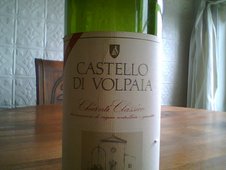
Grecomusc'? What the hell? I stared at the strange bottle on the table at Smith & Vine. Did someone misspell Greco? Or was that a fanciful name for the wine, made up by the vintner, Campania's Cantina Lonardo?
The clerk told me, no, Grecomusc'—apostrophe and all—was the name of the grape varietal. I felt suddenly ignorant. I'd never heard of it. So I bought it and went home and consulted the library. Nope, nope, nope—none of the major reference guides mentioned it. The clerk was wrong. It was probably plain old Greco di Tufo. But, just to be sure, I consulted the website of Polaner, the wine's importer. And what do you know? Grecomusc' is a grape! But I didn't feel dumb for not knowing about it anymore. Told the site:
Grecomusc', so-called in the local dialect, is a super rare, indigenous varietal grown only in Irpinia. It is a cousin of the grape Greco, and is grown on 70 year old vines in volcanic-clay soils. Cantina Lonardo is the only producer to bottle this grape individually (whereas others usually cultivate this grape alongside the ubiquitous Greco). This estate parcel is grown entirely on ungrafted rootstocks. It is located about 350-400 meters above sea level.
The only producer of the grape to bottle it as is, not as a blending agent! Wow. Talk about singular.
For such a rarity, it was cheaply had. Only $12. Still, at that price, it might still be a hard sell. I mean, I love this stuff. I'm going to go buy more. But I can see how few others would. This wine—fermented with native yeasts, and aged four months in five hectoliter tonneaux, followed by two months in stainless steel—is the opposite of fruit forward. The nose very nearly repels. It smells of burnt rubber, oil, ginko, with almost zero fruit. It is an intense and intriguing nose. The mouthfeel is fullsome, strong, aggressive. There is fruit here, but on the raw side: unripe grape, green plum, white melon, white current. Add some white flowers, diesel, lighter fluid, fingernail polish, and saltiness, and you've got a sensory challenge on your hands. As Polaner admits, this is almost a "tannic white." (As it warms up, some ripe pear hidden at the center comes out.)
I've called it as a saw it, and the picture may not sound pretty, but take my word: this is a great and unique wine which will go with innumerable dishes, its acidity cutting through the fattiest thing you can serve, and its body standing up to hearty food. It's rustic and muscular, yet dignified and elegant.
Cantina Lonardo, a small, 11-year-old winery, also makes some Aglianicos, which are advertised as "old and soulful." I will be looking for them.


